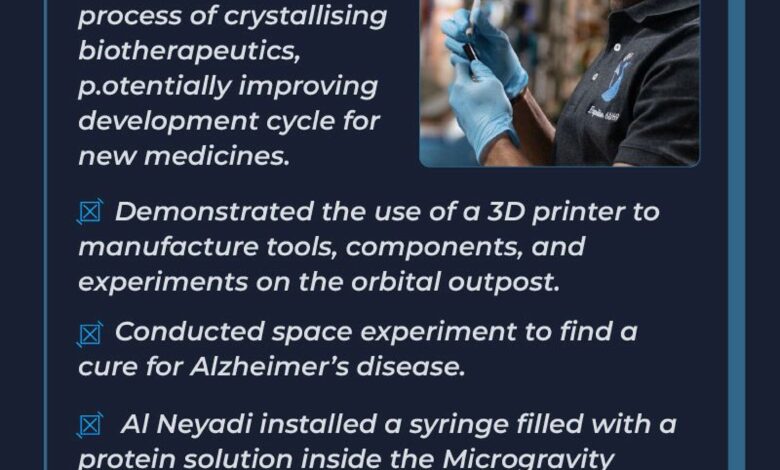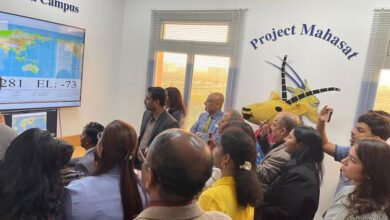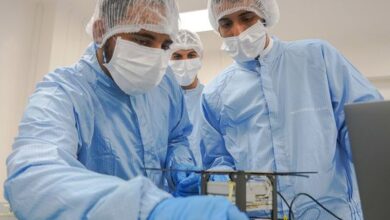Why did Sultan Al Neyadi of the United Arab Emirates conduct experiments aboard the International Space Station?

[ad_1]
UAE astronaut Sultan Al Neyadi spent six months in space conducting around 200 scientific experiments. The results of these experiments would produce new discoveries and technological advances that could benefit future space missions and people on Earth.
The space offers a unique environment for experiments. The International Space Station (ISS) has been an orbiting laboratory since it was inhabited in 2000, and thousands of experiments have been carried out over the past 23 years.
Why are so many experiments carried out on the space station? Can’t this be done on Earth? What are the benefits of conducting experiments aboard the ISS?
The simple answer is that these experiments cannot be performed on Earth, where gravity impacts everything. It determines how blood is pumped from human hearts and how plant roots grow. In this way, gravity becomes an important factor, which does not happen on the space station.
What is microgravity?
The space station, which floats 400 kilometers above Earth, offers a laboratory where gravity is so low that objects float. Microgravity or weightlessness is the best reason to conduct tests aboard the ISS. The space station offers permanent weightlessness as it orbits the Earth every 90 minutes. That makes the ISS a laboratory with a perennial microgravity environment.
Is zero gravity the same as microgravity?
Although the two terms are used interchangeably, gravity in space is often called microgravity, since there is a small amount of gravity everywhere. Gravity keeps the Moon in orbit around the Earth and the Earth in orbit around the Sun. It is impossible to “turn off” gravity. To simulate microgravity, the pull of gravity must be balanced with another force (fall, in the case of the ISS, NASA simulator planes, free fall attractions or towers).
Why do astronauts experience weightlessness in space?
As the space station orbits the Earth, gravity constantly pulls it toward the ground. Since the station also moves very fast in orbit (the ISS travels at 28,000 km/hour), its movement coincides with the curvature of the Earth. It is falling around the Earth and this constant falling motion creates a feeling of weightlessness, according to a report in Science News Explores.
Can microgravity be created on Earth?
Microgravity can be created on Earth, but only for short periods. NASA creates microgravity by flying planes in parabolas up and down. At the top of the parabola, people and objects inside the plane feel weightlessness (free fall) for about 20 to 30 seconds. Fleeting experiences of microgravity occur during roller coaster rides and free falls at amusement parks.
How does microgravity affect physical and chemical processes?
Many physical and chemical processes change in the absence of gravity, providing new opportunities to study boiling, melting, mixing of fluids and gases in ways that are not possible on Earth, according to NASA’s website.
Without gravity, hot air does not rise and flames become spherical. Fluids also behave differently as microgravity affects surface tension and capillary forces.
What are the experiments carried out on board the ISS?
These are some of the scientific and medical experiments carried out in microgravity. Some of the results have had applications on Earth.
Study of fundamental physics: In a nearly weightless environment, researchers can investigate the behavior of matter and physical processes that are obscured by the influence of gravity on Earth. This includes experiments related to fluid dynamics, combustion, heat transfer and crystal growth, which can lead to advances in various scientific and industrial fields.
Biomedical research: Microgravity offers insights into the effects of spaceflight on the human body. Researchers can study changes in bone density, muscle atrophy, cardiovascular health and the immune system in astronauts. These studies help scientists understand the health challenges astronauts face during long-duration space missions and may have applications for improving healthcare on Earth, such as in osteoporosis research or the treatment of osteoporosis-related diseases. the muscles.
Drug development and protein crystal growth: Microgravity enables the growth of higher quality protein crystals, which are essential for structural biology and drug development. These crystals can be studied with greater precision, leading to a better understanding of the structures of biomolecules and potentially accelerating the development of new drugs.
Fluid and materials science: Microgravity allows researchers to perform experiments with liquids and materials that would be impossible or impractical on Earth. For example, the behavior of fluids, foams and granular materials can be explored, which will lead to advances in materials science and aerospace engineering.
Space medicine: Microgravity medical research can help identify and mitigate health risks associated with space travel. This includes studying the effects of radiation exposure, fluid changes in the body, changes in vision, and psychological factors. These findings may lead to the development of countermeasures and strategies to protect astronauts on long-duration missions.
Life sciences: Microgravity allows the study of various forms of life, from microorganisms to plants and animals, in a unique environment. Understanding how these organisms adapt and interact with microgravity can provide insights into fundamental biological processes and may have applications in agriculture and medicine.
Technological Advances: Conducting experiments in microgravity often requires the development of specialized equipment and technologies. These innovations can have broader applications beyond space research and lead to the creation of new technologies and industries.
Image credit: Gulf News
Why can’t microgravity experiments be performed on Earth?
Microgravity cannot be created on Earth for sustained periods of time long enough to conduct experiments. Space, with its microgravity, offers the best place for such trials, making the International Space Station in low Earth orbit the ideal place to carry out such experiments. And hundreds of research studies are carried out aboard the ISS every year.
What are the other benefits of the ISS laboratory?
In addition to microgravity, the space station environment offers increased exposure to high levels of radiation, which can be used to study the effects of radiation on living materials and organisms.
The space station also offers an excellent view of Earth in different conditions, making it an observation post. The crew and instruments aboard the ISS can observe 85 percent of the Earth’s surface and take photographs. It helps track urban growth, study weather patterns, monitor hurricanes and volcanic eruptions, document melting glaciers and deforestation, and measure carbon dioxide in the atmosphere.
Extreme temperature fluctuations in space allow scientists to test the durability of materials and materials in hostile conditions.
Can the space station help monitor climate change?
From their vantage point on the ISS, astronauts collect images and data to monitor Earth’s land masses, water, air, vegetation and other resources. The data helps track storms, fires and other extreme weather events.
“Monitoring water and energy cycles, changes in ecosystems, population migration patterns and other developments help inform environmental research and climate science,” says a report from the World Economic Forum.
When researchers become guinea pigs
The astronauts carry out a series of scientific experiments on the space station, but they themselves become subjects of some experiments. They are both scientists and guinea pigs.
“We participate in studies on osteoporosis, DNA mutations, as well as blood vessels and their changes (in microgravity). Our goal is to understand the effects of zero gravity on humans and the potential dangers of deep space travel,” Al Neyadi said.
While some of these experiments yield solutions for diseases on Earth, the results of many studies will be invaluable when humans travel to Mars and deep space in the future. Interstellar travel may no longer be science fiction.
[ad_2]




